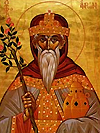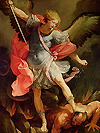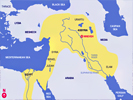|
Aaron (אַהֲרֹן)
Hebrew. The brother of Moses
and great-grandson of Levi, the 3rd son of Jacob by Leah, and
accordingly also known as Aaron the Levite. He was the elder son of
Amram and Jochebed and three years older than Moses. The meaning of his name is
uncertain, but might be “bringer of light”, a name reminiscent of
Lucifer. He was the first High Priest of
the Old Law and as such a pre-figuration of Jesus Christ, the first and
sole Sovereign Priest of the New Testament. He married Elisheba, the
daughter of Amminadab of the house of Judah, by whom he had four sons,
Nadab, Abihu, Eleazar and Ithamar. He was sent to Egypt by God to speak
on behalf of Moses and stand by him, especially during his court
dealings with
Pharaoh. When Moses ascended the mount to receive the Ten Commandments,
Aaron and his two sons, Nadab and Abihu, along with seventy elders of
the tribe of Israel, accompanied him part of the way, but whilst Moses
remained on the mountain, Aaron returned to the people and they made a
golden calf as an object of worship. When Moses returned to the camp,
Aaron was rebuked for his part in this, but finally forgiven. After many
years in the desert, the chiefs of the tribes were each required to
bring to Moses a rod bearing on it the name of his tribe, which were,
along with the rod of Aaron for the tribe of Levi, laid up overnight in
the tabernacle. In the morning it was found that while the other rods
remained unchanged, that of Aaron budded, blossomed and yielded almonds.
This rod was afterwards preserved in the tabernacle as a memorial of the
divine attestation of his appointment to the priesthood.


Adam
(אָדָם)
1. Hebrew. “Man” or “mankind”, but
also “dust”, thus endorsing the text of Genesis 2:7 “And the LORD God formed
man of the dust of the ground”. In Hebrew, the word adamah
(אֲדָמָה) means “earth” or “ground”. Being the first human
and made
from dust it is thus only logical that he was named Adam. More than
a name it thus also refers to his nature as a human being. Though
the word for man is in the singular, when in the text a pronoun
is used, it is rendered by the plural them, supporting the idea
that the
word may be used more broadly to indicate all humankind. From
one of Adam's ribs, God created Eve, as his wife and a suitable
companion.
Though, through the cunning deceit of the
serpent she brought about the fall of man, as she gave the fruit of the Tree of Knowledge of Good and Evil
unto Adam to eat, thus violating God's direct commandment, not to
eat from it. The root אדם is also used in the word
adam (אָדַם) which means “to become red” or
“to blush”,
perhaps a reference to the shame that befell Adam after he had sinned,
by eating from the fruit of the Tree of Knowledge.

2. Name of a city mentioned in Joshua 3:16.
It is situated near Zar'ethan, a city in
the middle of the Jordan valley.

adelphopoiesis (ἀδελφοποίησις)
Greek. “Brother-making”. Term for a fraternization
ceremony which was practiced at some point in the past by various
Christian churches, mainly by the Eastern Orthodox Church, to
spiritually unite two people of the same sex, usually men. The term
derives from the Greek words adelphos (ἀδελφός), meaning
“brother” and
poi-eo (ποιέω), which translates as “I make”. Being a same-sex union,
though not romantic nor carnal but only referring to the biological
condition of the partakers, some modern historians have compared it to
the disputed present-day gay marriages, an interpretation contested by
most theologians, who see the rite merely as a pact between religious
brothers.

adyton (ἄδυτον)
Greek. “Not to be entered”, i.e. a restricted area
or place not to be entered. The term refers to the inner-most sacred
shrine of a Greek or Roman temple, usually a small area at the farthest
end of the cella from the entrance. Frequently, such shrines are
associated with chthonic deities and would often house the cult image of
a god. Such spaces were reserved for oracles, priests or acolytes, and
not open to the general public. The adyton is reminiscent of the Hebrew
Holy of Holies, the inner sanctuary and most sacred site in traditional
Judaism. One existed in the temple to Apollo at Delphi, perhaps a
left-over from Gaia's worship there, as mentioned in the Oresteia
(Ὀρέστεια), a trilogy of Greek tragedies written by Aeschylus. In Latin
it is known as adytum. See also
Kodesh Hakodashim.

Ælfric of Eynsham
Name of a 10th-century (ca. 957 – ca. 1010)
Anglo-Saxon Benedictine monk and prolific writer in Old English of
hagiography, homilies, biblical commentaries, and other genres. He is
best known for his three homiletic collections (about 120 sermons), the
first English translations of passages from several Old Testament books,
pastoral letters, and other pedagogical materials.
Ælfric probably came from a parish
near Winchester where he joined a Benedictine abbey, then under the rule
of Aelthelwold, a reforming clergyman who was a follower of the
Benedictine Rule. When he first arrived at the abbey he was shocked by
the behaviour of the monks. Writing 40 years later, Ælfric described
them as drunken and riotous, with wives and children! Aethelwold saw in
Ælfric a righteous monk and educated him wisely so that he in turn could
take on responsibilities. When he was about thirty he was sent to Cerne
Abbey in Dorset (southwest England)
to help establish the Rule of Benedict. It was there that he did most of
his writing as well as teaching. In 998, a
ruthless Viking army raided the Dorset countryside.
In 1005 Ælfric was sent to
Eynsham to be its first Abbot, when it was given its foundation Charter.
He died about 5 years later, probably at the age of 53. The exact date
is not known, but there are no more of his writings after 1010.
He is also known variously as Ælfric Grammaticus,
Ælfric of Cerne and Ælfric the Homilist.


agon (αγών)
Greek. “Struggle” or “contest”. Term that can
refer to athletic contests, such as the Olympics, but which can also
signify a battle or a trial, i.e. a legal battle. Thus it may also be a
speech delivered in a court or the main argument of a speech. From this,
it becomes the technical term for the main debate or rhetorical argument
in an Old Comedy. Pronounced and also spelled agoon.

Alpha (α)
The first letter of the Greek alphabet. In
combination with Omega, the last letter of the Greek alphabet, it is
also a title of Christ, i.e. “I am the Alpha and the Omega”, who is and
who was and who is to come, as stated in Revelation. This relates to
several texts in the Old Testament where God the LORD said “I am He, I
am the first, and I am the last”.

Amalek (עֲמָלֵק)
Name of a biblical figure whose name came to
signify Israel’s archetypal enemy and a symbol of enduring opposition to
the divine order. The etymology of the name is uncertain. Some scholars
have proposed a derivation from a Semitic root ʿ-ml-q (מלק), meaning “to
toil” or “to wring”, though this remains conjectural, while others
regard it as a non-Hebrew ethnonym referring to a desert tribe
inhabiting the southern reaches of Canaan. In the Hebrew Bible, Amalek
appears as the grandson of Esau, born to Eliphaz by his concubine Timna
(Genesis
36:12). His descendants, the Amalekites, are described as a
nomadic people dwelling in the Negev and the region between the Dead Sea
and the Sinai Peninsula. Their first recorded encounter with the
Israelites occurs in
Exodus 17:8–16, when they attack the
Israelites at Rephidim soon after the Exodus from Egypt. This assault
provokes divine condemnation, and Yahweh declares perpetual war against
Amalek, commanding that his memory be blotted out from under heaven
(Deuteronomy 25:17–19). The Amalekites reappear in the narratives of the
early monarchy: Saul’s failure to annihilate them completely, as ordered
by the prophet Samuel, leads to his rejection as king (1 Samuel 15),
while later accounts depict David pursuing and defeating remnant groups
of Amalekites (1 Samuel 30). Historically, the Amalekites seem to vanish
from the record after the Davidic period, and there is no conclusive
extrabiblical evidence identifying a tribe by this name. Archaeological
and textual studies have suggested possible affinities with nomadic
Edomite or Midianite groups, but these remain speculative. In later
Jewish tradition, Amalek assumes a typological and theological
significance far beyond his historical identity. Rabbinic literature
interprets Amalek as the embodiment of moral and spiritual opposition to
God, representing irrational hatred, doubt, and the negation of faith.
The command to erase Amalek’s memory came to be understood not as a call
for literal extermination but as a perpetual moral imperative to oppose
evil and injustice. In mystical readings, Amalek is identified with the
inner force that weakens belief and sows division within the community
of Israel. In Christian typology, Amalek is frequently treated as a
figure for sin, the flesh, or the devil, against whom believers must
wage spiritual warfare, recalling Moses’ raised hands during Israel’s
victory at Rephidim. Throughout history, the name Amalek was invoked
metaphorically to describe Israel’s persecutors, from Haman in the Book
of Esther to later oppressors, but modern Jewish ethics insist that such
associations remain symbolic rather than ethnic. Thus, Amalek stands as
both a historical memory and a theological construct—a figure who began
as a tribal ancestor in the genealogies of Genesis but evolved into a
lasting symbol of enmity, moral testing, and the struggle between divine
justice and human malevolence. In an address on 28 October 2023, during
Israel’s campaign in Gaza, Prime Minister Benjamin Netanyahu cited
Deuteronomy 25:17, saying, “You must remember what Amalek has done to
you”. The verse recalls how the Amalekites attacked the Israelites’
weakest in the desert. Netanyahu used the reference to frame the Hamas
assault of 7 October as a repetition of such cruelty toward the
defenceless. Several media outlets and international critics interpreted
the remark as a biblical call to genocide, noting that the Amalek story
includes God’s command to erase Amalek’s memory. Netanyahu’s office
rejected this interpretation as “false and preposterous”, explaining
that the verse was meant to condemn Hamas’s brutality, not to advocate
violence against civilians. The biblical allusion, they said, evoked
remembrance of evil deeds, not a call for extermination. The office
pointed out that the claim that his statement was a genocide call “false
and preposterous”, stating it reflected “a deep historical ignorance”,
and that the same phrase or allusion appears in memorial contexts — for
example at the Yad Vashem Holocaust museum and a memorial in The Hague
for Dutch Jews — and asserted that such appearances cannot reasonably be
interpreted as incitement to genocide.


Anglicanism
The Christian tradition and
ecclesiastical system originating from the
Church of England,
characterized by a blend of
Reformation
theology and historic
Catholic
liturgy. It upholds the authority of Scripture (sola scriptura),
emphasizes justification by faith, and maintains a hierarchical
structure of church governance under bishops (episcopacy). Anglicanism
is distinguished by its liturgical practices, the Book of Common Prayer,
and its often moderate or “via media” approach, seeking a balance
between
Catholic
and
Protestant
elements in doctrine, worship, and church order. The term derives from
the Medieval Latin anglicanus, meaning “English”, reflecting its origins
in England. Anglicanism formally emerged in the 16th century during the
English
Reformation,
closely associated with King Henry VIII, who broke from the
Roman Catholic Church
in 1534 after Pope Clement VII refused to annul his marriage to
Catherine of Aragon. The Act of Supremacy declared Henry VIII the
Supreme Head of the
Church of England,
establishing Anglicanism as a distinct ecclesiastical body. While
initially driven by political and personal motives, the church quickly
incorporated theological reforms influenced by continental
Protestantism,
including aspects of
Lutheran and
Reformed
doctrines. Subsequent monarchs, such as Edward VI and Elizabeth I,
shaped its doctrinal and liturgical identity, with Elizabeth’s Religious
Settlement of 1559 defining a moderate “via media” between
Catholicism
and
Protestantism.
The English monarch continues to serve as the
Supreme Governor of the Church of England,
symbolizing the union of church and state, while spiritual leadership is
exercised by the
Archbishop of Canterbury and the
episcopal hierarchy.

Apocrypha (ἀπόκρυφα)
Greek. “Those having been hidden away”.
Term applied to
texts of uncertain authenticity or to writings where the legitimacy of
authorship is in question. In Judeo-Christian theology, the word
apocrypha refers to specific texts that some traditions do not consider
as canonical or biblical. Some of the Jewish apocrypha were part of the
regular religious literature of the early Christians.

archangel
An angel of a higher rank. The
name derives of the Greek archangelos (αρχάγγελος). Their total at least
numbers seven, with the chief one being the archangel Michael, followed
by two other higher archangels, who are known by the names Gabriel and
Raphael. According to the traditional Christian angelic hierarchy there
are three triads or spheres of celestial beings. Archangels together
with angels belong to the lowest order in the third sphere, being the
only celestial beings directly involved in the affairs of the world of
men. The highest ranking celestial beings therefore are the ones in the
first triad, which is headed by the Seraphim, followed by the Cherubim
and the Erelim, who are all related to the throne of God the Father.


Archbishop
of Canterbury
The senior bishop and principal leader of the
Church of England,
spiritual head of the
Anglican Communion worldwide, and
holder of the see at Canterbury, England. The Archbishop presides over
church governance, represents the church in national and international
matters, consecrates bishops, and provides spiritual guidance, serving
as the symbolic and administrative leader of
Anglicanism.

Archbishop of York
The second most senior bishop in the
Church of England,
subordinate only to the
Archbishop of Canterbury, and the
metropolitan of the Province of York, which covers the northern part of
England. The Archbishop of York assists in overseeing church governance,
ordains and consecrates clergy, and represents the Church in both
religious and civic matters, serving as a key figure in the leadership
of the
Anglican Communion.

Arianism
A theological doctrine in early
Christianity,
named after the Alexandrian priest
Arius (c. 256–336 AD), which held that
Jesus Christ,
the Son of God, was not co-eternal or consubstantial with God the
Father, but a created being who existed before the world was made.
Arianism challenged the traditional understanding of the Trinity,
asserting a hierarchy within the Godhead rather than equality among the
Father, Son, and Holy Spirit. The doctrine sparked major controversy in
the early Church, leading to the
First Council of Nicaea (325 AD), where
it was condemned as heretical and countered with the formulation of the
Nicene Creed, which affirmed the Son’s
full divinity and consubstantiality with the Father. Despite
condemnation, Arianism persisted in various regions for several
centuries, particularly among some Germanic tribes.

Arius
A
Christian
presbyter (c. 256–336 AD) from Alexandria, Egypt, Arius is best known as
the founder of
Arianism, a
Theological
doctrine asserting that
Jesus Christ,
the Son of God, was a created being and not co-eternal with God the
Father. His teachings challenged the emerging orthodox understanding of
the Trinity and sparked a major controversy in the early Church. Arius'
views prompted the
First Council of Nicaea (325 AD),
convened by Emperor
Constantine I,
which condemned
Arianism as heresy and affirmed the
Nicene doctrine that the Son is homoousios (ὁμοούσιος), i.e. “of the
same essence” as the Father. Arius continued to influence Christian
communities in parts of the Eastern Roman Empire until his death in 336
AD. Although
Arianism had largely disappeared from
the Eastern Empire by the sixth century, it persisted in parts of
Western Europe, particularly among Germanic kingdoms such as the
Visigoths in Spain, the Ostrogoths in Italy, and the Burgundians and
Lombards in parts of Gaul and Italy, whose earlier conversions to
Christianity
had not fully embraced Nicene orthodoxy. In response, the Western Church
formally adopted the
Filioque clause at the Third Council of
Toledo (589 AD) in Spain, in the context of the conversion of the
Visigothic kingdom to Nicene
Christianity.
The
Filioque was part of broader efforts to
affirm Trinitarian orthodoxy against residual
Arian beliefs. The inclusion of the
Filioque clause in the Latin Church
would later become one of the theological and doctrinal disputes
contributing to the Great
Schism of 1054,
also called the
East–West Schism.

Assyria (Ἀσσυρία)
A major ancient Near Eastern kingdom frequently
mentioned in the Hebrew Bible, where it is known as Asshur (אֲשׁוּר). It
is located in the northern Mesopotamian region along the upper
Tigris
River. In biblical texts, Assyria is both a geographical and political
entity, often representing a powerful and sometimes hostile empire that
interacts with Israel and Judah. It is first associated with the
descendants of
Shem
through Asshur (Genesis 10:11–12), and later narratives depict Assyria
as the conqueror of the northern kingdom of Israel, carrying the
Israelites into exile (2 Kings 17:6). Prophetic literature, including
Isaiah, Micah, and Nahum, frequently portrays Assyria as an instrument
of divine judgment as well as a symbol of human pride and oppression.
The biblical portrayal emphasizes Assyria’s military might, its role in
shaping the history of Israel and Judah, and its ultimate subjugation by
God, reflecting both historical and theological perspectives on empire,
power, and divine sovereignty.

 |